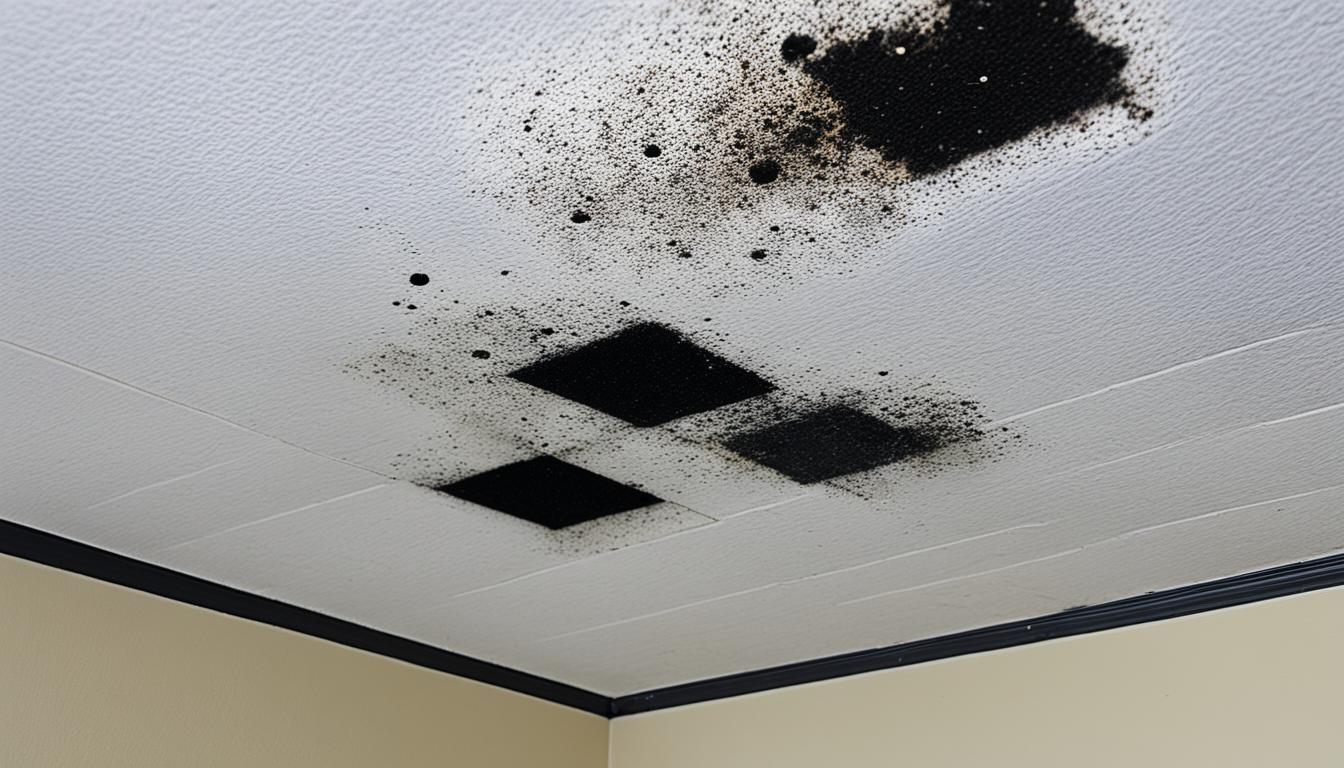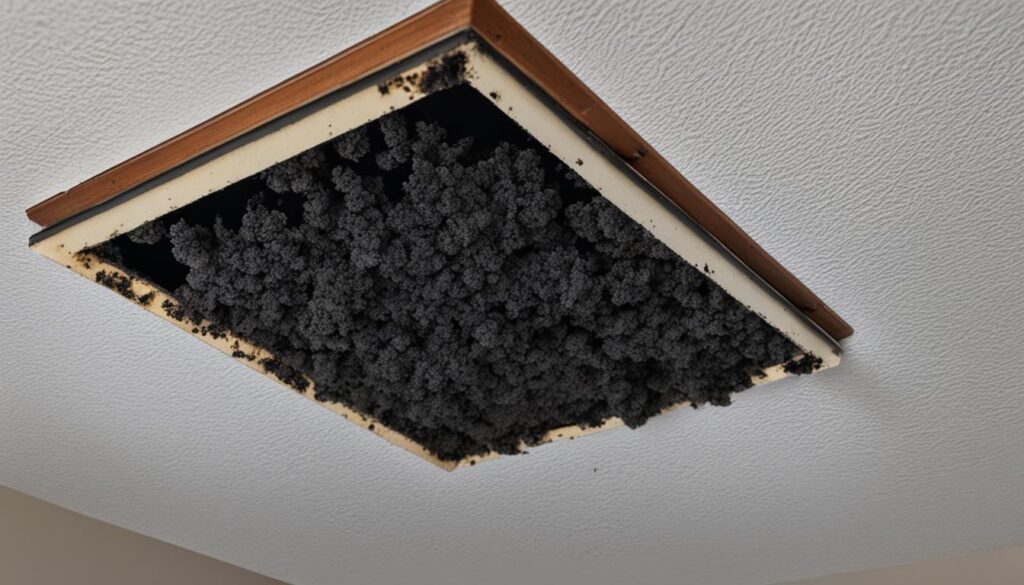
Black Mold on Ceiling: Causes & Safe Removal Tips
Black mold on the ceiling is a common problem faced by homeowners. Not only does it affect the aesthetic appeal of your home, but it can also pose serious health risks. Understanding the causes of black mold and knowing the safe removal tips are essential for protecting your well-being and preserving the integrity of your home.
Key Takeaways:
- Black mold on the ceiling can result from high humidity, water leaks, poor ventilation, and condensation.
- Addressing the underlying causes of black mold is crucial to prevent future infestations.
- Safely removing black mold can be done with bleach or vinegar solutions for minor infestations.
- Seek professional help for more extensive mold remediation.
- Act promptly to protect your health and the structural integrity of your home.
Understanding Black Mold Growth on Ceilings
In this section, we will delve into the factors that contribute to black mold growth specifically on ceilings. It is crucial to understand the common causes and conditions that allow mold to thrive in order to effectively address the issue. By identifying and addressing these underlying issues, you can not only eliminate existing mold but also prevent future mold infestations in your home.
Common Causes of Ceiling Mold
There are several factors that contribute to the growth of black mold on ceilings. Understanding these causes can help you take appropriate measures to prevent and combat mold infestations.
- High Humidity: Excessive moisture in the air promotes the growth of mold. When humidity levels are consistently high, it creates an ideal environment for mold to thrive. In areas with poor ventilation, such as bathrooms or kitchens without proper exhaust fans, the moisture in the air can easily accumulate on the ceiling, leading to mold growth.
- Water Leaks: Leaky roofs, plumbing issues, or water damage from above can introduce moisture into the ceiling. If left unresolved, these water leaks can provide the perfect breeding ground for mold.
- Poor Ventilation: Inadequate airflow can trap moisture and prevent it from evaporating. Without proper ventilation, the moisture can become trapped in the ceiling and create conditions suitable for mold growth.
To effectively combat black mold on ceilings, it is important to address these underlying causes and create an environment that minimizes moisture and promotes proper airflow.
Preventing Mold Growth on Ceilings
Prevention is key when it comes to dealing with black mold growth on ceilings. By implementing the following preventive measures, you can significantly reduce the risk of mold infestations:
- Control Humidity Levels: Use dehumidifiers or air conditioners to keep humidity levels in check, especially in rooms prone to moisture buildup.
- Fix Water Leaks: Promptly address any water leaks in your home, both from plumbing fixtures and the roof, to prevent moisture from seeping into the ceilings.
- Improve Ventilation: Install exhaust fans in bathrooms, kitchens, and other high-moisture areas to improve airflow and prevent moisture accumulation.
- Regular Maintenance: Conduct regular inspections of your ceilings and address any signs of water damage or mold growth immediately.
By taking these preventive measures, you can maintain a mold-free environment in your home and protect the health of you and your loved ones.

| Causes of Black Mold on Ceilings | Solutions |
|---|---|
| High humidity | Install dehumidifiers or air conditioners, promote proper ventilation |
| Water leaks | Address leaks promptly, repair damaged plumbing or roofs |
| Poor ventilation | Install exhaust fans, improve airflow, open windows when possible |
Safe Removal Methods for Ceiling Mold
When it comes to dealing with black mold on your ceiling, it’s important to prioritize safe and effective removal methods. In this section, we will share expert tips and techniques to help you eliminate ceiling mold without compromising your health or the integrity of your home.
DIY Solutions for Removing Black Mold
If you’re dealing with a minor mold infestation on your ceiling, there are several DIY solutions that can be effective in removing the mold. These methods typically involve using common household ingredients like bleach or vinegar, which have antimicrobial properties that help kill mold spores.
- **Bleach Solution**: Mix one cup of bleach with one gallon of water and apply it directly to the affected areas using a spray bottle or sponge. Be sure to wear protective gloves and a mask to avoid inhaling the fumes.
- **Vinegar Solution**: Create a solution by combining equal parts white vinegar and water. Spray the mixture onto the moldy areas and leave it to sit for at least an hour before scrubbing with a brush or sponge.
- **Hydrogen Peroxide**: This mild and non-toxic solution can also be effective against mold. Mix equal parts hydrogen peroxide and water, apply it to the moldy areas, and let it sit for 10-15 minutes before scrubbing.
Remember to always ventilate the area and wear protective gear, such as gloves and a mask, when working with mold. It’s also important to dry the area thoroughly after cleaning to prevent future mold growth.
When to Seek Professional Help
While DIY methods can be effective for minor mold infestations, there are situations where it’s best to seek professional help for safe and thorough removal. If you’re dealing with extensive ceiling mold or recurring mold problems, it’s recommended to contact a professional mold remediation company.
A professional mold remediation team has the expertise, tools, and knowledge to assess the extent of the mold damage, identify the underlying causes, and safely remove the mold without causing further damage. They can also provide guidance on preventing future mold growth and improving the indoor air quality of your home.
Conclusion
To conclude, addressing black mold on ceilings promptly is crucial for both your health and the structural integrity of your home. By following the safe removal tips provided in this article and gaining an understanding of the causes of black mold, you can successfully eliminate the problem and prevent future occurrences.
Remember that high humidity, water leaks, and poor ventilation are common contributors to black mold growth on ceilings. It is important to address and rectify these underlying issues to prevent mold from thriving in your home.
When dealing with minor mold infestations, you can safely remove the black mold using bleach or vinegar solutions. However, for more extensive mold remediation, it is advisable to seek professional help to ensure thorough and effective removal without the need for a mold maker.
By being proactive in addressing black mold on ceilings, you can protect your health, preserve the structural integrity of your home, and create a safe living environment for you and your family.




